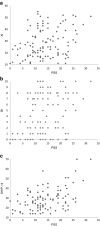Relationship among perceived stress, xerostomia, and salivary flow rate in patients visiting a saliva clinic
- PMID: 29520470
- PMCID: PMC6224012
- DOI: 10.1007/s00784-018-2393-2
Relationship among perceived stress, xerostomia, and salivary flow rate in patients visiting a saliva clinic
Abstract
Objective: This aimed to assess the potential role of chronic stress in saliva secretion, xerostomia, and oral health in a population attending a saliva clinic.
Materials and methods: Data of 114 patients who met the inclusion criteria and completed all questionnaires were analyzed in this study. Participants completed several validated questionnaires, including the Perceived Stress Scale, the Oral Health Impact Profile (OHIP-14), Xerostomia Inventory (XI), and Bother xerostomia Index (BI). Subsequently, the unstimulated, chewing-stimulated, and citric acid-stimulated saliva secretion rates were determined gravimetrically. Data were evaluated using Spearman's correlation analysis and the Mann-Whitney U test.
Results: A significant correlation was observed between perceived stress and XI score (r = 0.312, p = 0.001), as well as between perceived stress and BI score (r = 0.334, p = 0.001). Stress levels also were significantly associated with OHIP-14 scores (r = 0.420, p < 0.001), but an association between experienced stress and salivary flow rate could not be established.
Conclusion: In this population, perceived chronic stress seems to be related to several aspects of dry mouth, including the perception of dry mouth, suffering from dry mouth, and the impact on quality of life. These effects were independent of the use of psychotropic medication. No actual reduction in salivary flow was found. Further studies to explore the causal linkage of stress with xerostomia seem warranted.
Clinical relevance: Perceived chronic stress seems to be related with several aspects of dry mouth. This finding might be relevant in future prevention and treatment of xerostomia.
Keywords: OHIP; Perceived stress; Saliva; Xerostomia.
Conflict of interest statement
Conflict of interest
The authors declare that they have no conflict of interest.
Ethical approval
This study followed the Declaration of Helsinki on medical protocol and ethics and was performed in accordance with the guidelines of the Medical Ethical Committee of the VU University Medical Center. According to the Ethics Review Committee of the VU University Amsterdam, the present study does not fall under the scope of the Medical Research Involving Human Subjects Act (WMO).
Informed consent
Written informed consent was obtained from all individual participants included in the study.
Figures
Similar articles
-
Assessing the impact of menopause on salivary flow and xerostomia.Aust Dent J. 2013 Jun;58(2):230-4. doi: 10.1111/adj.12057. Aust Dent J. 2013. PMID: 23713645
-
Type 1 diabetes mellitus, xerostomia, and salivary flow rates.Oral Surg Oral Med Oral Pathol Oral Radiol Endod. 2001 Sep;92(3):281-91. doi: 10.1067/moe.2001.117815. Oral Surg Oral Med Oral Pathol Oral Radiol Endod. 2001. PMID: 11552145
-
Determining the relationship among stress, xerostomia, salivary flow rate, and the quality of life of undergraduate dental students.J Taibah Univ Med Sci. 2020 Nov 24;16(1):9-15. doi: 10.1016/j.jtumed.2020.10.019. eCollection 2021 Feb. J Taibah Univ Med Sci. 2020. PMID: 33603626 Free PMC article.
-
[Buccal dryness, xerostomia and measurement of salivary secretory activity].Ann Med Interne (Paris). 1997;148(3):209-16. Ann Med Interne (Paris). 1997. PMID: 9255328 Review. French.
-
The effect of gum chewing on xerostomia and salivary flow rate in elderly and medically compromised subjects: a systematic review and meta-analysis.BMC Oral Health. 2023 Jun 20;23(1):406. doi: 10.1186/s12903-023-03084-x. BMC Oral Health. 2023. PMID: 37340436 Free PMC article.
Cited by
-
Differing salivary microbiome diversity, community and diurnal rhythmicity in association with affective state and peripheral inflammation in adults.Brain Behav Immun. 2020 Jul;87:591-602. doi: 10.1016/j.bbi.2020.02.004. Epub 2020 Feb 14. Brain Behav Immun. 2020. PMID: 32061904 Free PMC article. No abstract available.
-
The association between oral dryness and use of dry-mouth interventions in Sjögren's syndrome patients.Clin Oral Investig. 2022 Feb;26(2):1465-1475. doi: 10.1007/s00784-021-04120-2. Epub 2021 Aug 10. Clin Oral Investig. 2022. PMID: 34374853 Free PMC article.
-
Association between COVID-19 stress, coping mechanisms and stress-related oral conditions among Egyptian adults: a cross-sectional study.Sci Rep. 2022 Oct 27;12(1):18062. doi: 10.1038/s41598-022-22961-z. Sci Rep. 2022. PMID: 36302880 Free PMC article.
-
Salivary Assessments in Post-Liver Transplantation Patients.J Clin Med. 2022 Jun 1;11(11):3152. doi: 10.3390/jcm11113152. J Clin Med. 2022. PMID: 35683539 Free PMC article.
-
The Impact of Dental Environment Stress on Dentition Status, Salivary Nitric Oxide and Flow Rate.J Int Soc Prev Community Dent. 2020 Apr 17;10(2):163-170. doi: 10.4103/jispcd.JISPCD_427_19. eCollection 2020 Mar-Apr. J Int Soc Prev Community Dent. 2020. PMID: 32670904 Free PMC article.
References
-
- Dawes C, Pedersen AML, Villa A, Ekström J, Proctor GB, Vissink A, Aframian D, McGowan R, Aliko A, Narayana N, Sia YW, Joshi RK, Jensen SB, Kerr AR, Wolff A. The functions of human saliva: a review sponsored by the world workshop on oral medicine VI. Arch Oral Biol. 2015;60:863–874. doi: 10.1016/j.archoralbio.2015.03.004. - DOI - PubMed
-
- Thomson WM, Chalmers JM, Spencer AJ, Williams SM. The xerostomia inventory: a multi-item approach to measuring dry mouth. Community Dent Health. 1999;16:12–17. - PubMed
MeSH terms
LinkOut - more resources
Full Text Sources
Other Literature Sources
Medical
Miscellaneous


